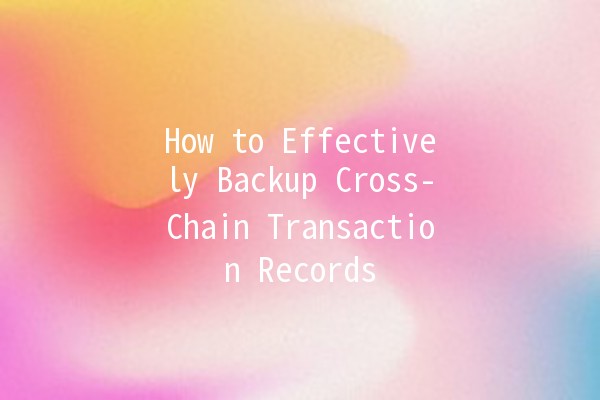
Managing transactions across multiple blockchain networks poses significant challenges, especially when it comes to backing up records. Crosschain transactions are a crucial aspect of modern blockchain applications as they allow interoperability between different platforms. However, ensuring that these transactions are backed up properly is vital for both security and accountability.
In this article, we'll discuss effective strategies to backup crosschain transaction records, providing actionable techniques for enhancing your productivity and ensuring the integrity of your data. We’ll also explore how to manage the complexities that come with crosschain transactions.
Understanding CrossChain Transactions
Crosschain transactions refer to the process where assets or information are transferred between different blockchain networks. This has become increasingly important as more decentralized applications (dApps) emerge, needing to interact with various blockchains.
The main challenges involved in crosschain transactions include:
Data consistency: Ensuring that data across chains remains synchronized and accurate.
Security risks: Implementing effective security protocols to protect transaction records.

Complexity of various blockchain protocols: Managing the differences in technology and rules across chains.
By understanding these challenges, you can begin to implement effective strategies to confidently backup your crosschain transaction records.
One of the best practices for ensuring your crosschain transaction records are protected is to establish an automated backup protocol. Regular automated backups help in minimizing the risk of data loss due to system failures or other unforeseen issues.
Implementation Example:
Use backup software that supports blockchain integrations. For instance, tools like `DataVault` can automatically backup your blockchain assets and transaction records based on a defined schedule.
Schedule daily or weekly backups depending on transaction volume. This ensures that your records are updated without requiring manual intervention.
Productivity Tip:
Set reminders or monitor the completion status of automated backups to ensure they run as scheduled. By keeping track, you can address any issues promptly.
Backing up your crosschain transaction records to cloud storage provides both security and accessibility. Cloud services tend to offer robust encryption and redundancy which helps to keep your data safe.
Implementation Example:
Choose providers like Amazon Web Services (AWS), Google Cloud, or Microsoft Azure, which have strong security measures and compliance with data protection laws.
Use tools that support API integrations to streamline the backup process. For example, using `BackupHero` can help in automating uploading records to your chosen cloud platform.
Productivity Tip:
Create a structured folder hierarchy within your cloud storage to easily find and manage your archived transaction records. Consider tagging or labeling records for easier retrieval.
Given the unique nature of blockchain data, utilizing specific backup solutions that cater to blockchain protocols can enhance your backup effectiveness.
Implementation Example:
Tools like `BlockSafe` are designed to handle blockchain data and can automate the backup process. Consider using these tools to manage records across various blockchain networks effectively.
Regularly update the software to take advantage of new features and security updates.
Productivity Tip:
Stay informed about the updates offered by blockchain backup software. This ensures you leverage enhancements in functionality, which can save time and improve security.
Redundancy is key when it comes to data backup. Having multiple backup methods ensures that if one fails, another can be utilized.
Implementation Example:
Use a combination of local storage and cloud storage backup. For instance, maintain a local hard drive backup of transaction records alongside an external cloud backup service.
Regularly test your redundancy systems by trying to retrieve data from backups to ensure they function correctly.
Productivity Tip:
Develop a checklist of all backup methods you are using. This will help you review and troubleshoot your backup systems efficiently.
The backup process is not complete without regular monitoring and validation of backup data integrity. This ensures that your backedup records are accurate and accessible.
Implementation Example:
Periodically run integrity checks to verify that the data has been backed up correctly. Use hash functions to compare original data with backup records.
Set up alerts to notify you of any discrepancies found during integrity checks.
Productivity Tip:
Schedule regular reviews of your backup logs. This will help you spot issues early and ensure your backups are functioning as intended.
Frequently Asked Questions
Crosschain transactions allow for the transfer of assets or data between different blockchain networks. They are essential for the growth of decentralized applications (dApps) that require interoperability to function effectively.
The frequency of backups depends on the volume of transactions you handle. For organizations with high transaction frequencies, daily backups are recommended, while lower volumes may require weekly backups.
Several tools can automate blockchain data backups. Software like `DataVault`, `BlockSafe`, or cloud platforms such as AWS and Google Cloud offer functionalities to streamline your backup processes.
Yes, reputable cloud storage providers implement advanced security measures such as encryption, access controls, and data redundancy that protect sensitive information. However, choosing a wellrated vendor is crucial.
If you find corruption in your backup files, promptly retrieve the last valid backup. Investigate what caused the corruption, and implement measures to prevent recurring issues, such as enhancing monitoring systems.
Yes, employing multiple backup methods (local and cloud) is recommended to ensure redundancy. This practice increases data security and accessibility in case one backup method fails.
By implementing these strategies, you can ensure the safety and integrity of your crosschain transaction records. The need for secure and efficient backup methods is paramount in today’s fastevolving blockchain landscape. Reassess your current practices regularly, and make necessary adjustments to optimize your backup approach. Always remember that preparedness is key in managing crosschain transactions effectively.

